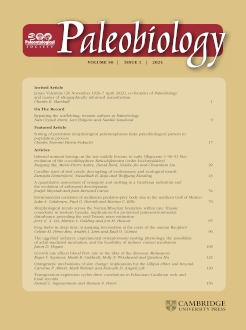Despite decades of nearly equal numbers of men and women as students, women remain underrepresented in the ranks of professional paleontology. Scholarly publishing is a gateway to the senior ranks, and journals are the gatekeepers. We asked whether the publishing infrastructure of the Paleontological Society supports gender equity. We reviewed all papers published by the society's journal, Paleobiology, from its inception in 1975 through 2021. Over the journal's run, the number of authors per paper increased due to cultural shifts toward collaborative research and acknowledging technical and support contributions with coauthorship. These shifts opened the door to more women, particularly beginning in the early 2000s, when the first women editors held the keys to the society's journals. Despite these gains, women remain chronically underrepresented. Change that supports one underrepresented group generally supports all. Therefore, we offer four recommendations to open the publishing gate to all intersectional identities: (1) review manuscripts without author identifiers; (2) recruit more editors from diverse backgrounds; (3) democratize the review process by including more and different voices; and (4) gather data on author demographics at the time of submission and analyze and report on these data regularly to see who is and who is not passing through the publishing gateway.
Women are underrepresented in paleontology. Despite more women students, representation at senior levels remains low. To advance professionally, scientists must disseminate their research through peer-reviewed publications. We examine gendered authorship patterns in Paleobiology to ask whether the publishing infrastructure supports the Paleontological Society's gender-equity goals. We reviewed all papers published in Paleobiology from its inception in 1975 through 2021. For each paper, we recorded each author, the author's position in the author list, and the total number of authors on each paper. We coded gender based on a combination of personal communication and pronouns used in publicly available information. We compared author demographics with anonymized membership data from the Paleontological Society. Over the journal's run, the number of authors per paper increased due to cultural shifts toward collaborative work and acknowledging student contributions with coauthorship. These trends contribute to proportionally more women authors, beginning in the early 2000s. Despite these increases, women remain chronically underrepresented. In 2018, 2019, and 2021, the proportion of women authors in Paleobiology paralleled membership in the Paleontological Society. However, in 2020, Paleobiology published fewer women authors than expected based on society membership. This echoes declines in women's scholarly productivity in the first year of the COVID-19 pandemic observed across many disciplines. We offer four recommendations: (1) practice double-anonymous peer review; (2) recruit editors from diverse backgrounds who invite reviewers with diverse backgrounds; (3) democratize manuscript review by selecting reviewers from a disaggregated reviewer database; and (4) gather and analyze demographic data for both submissions and publications.






